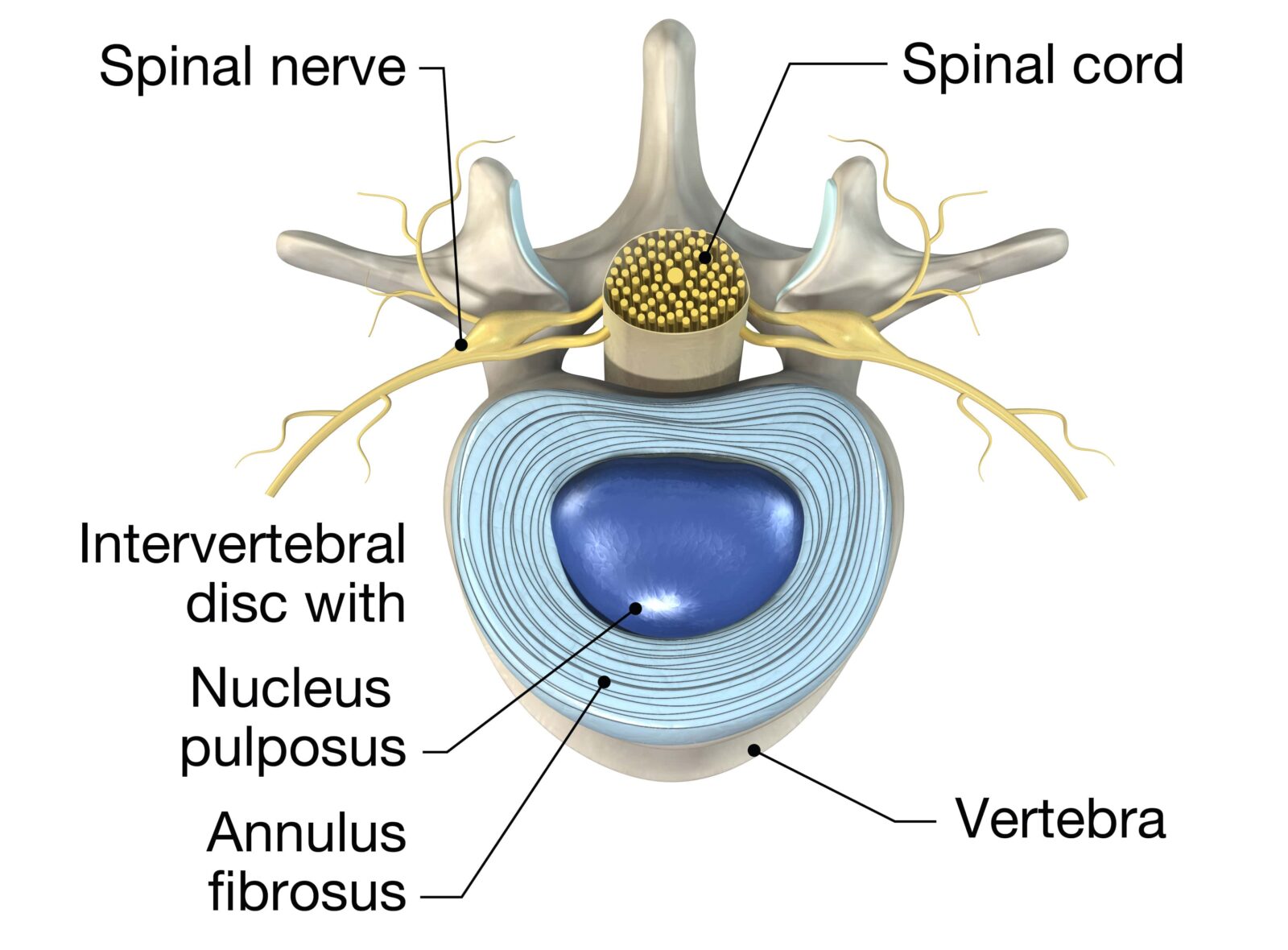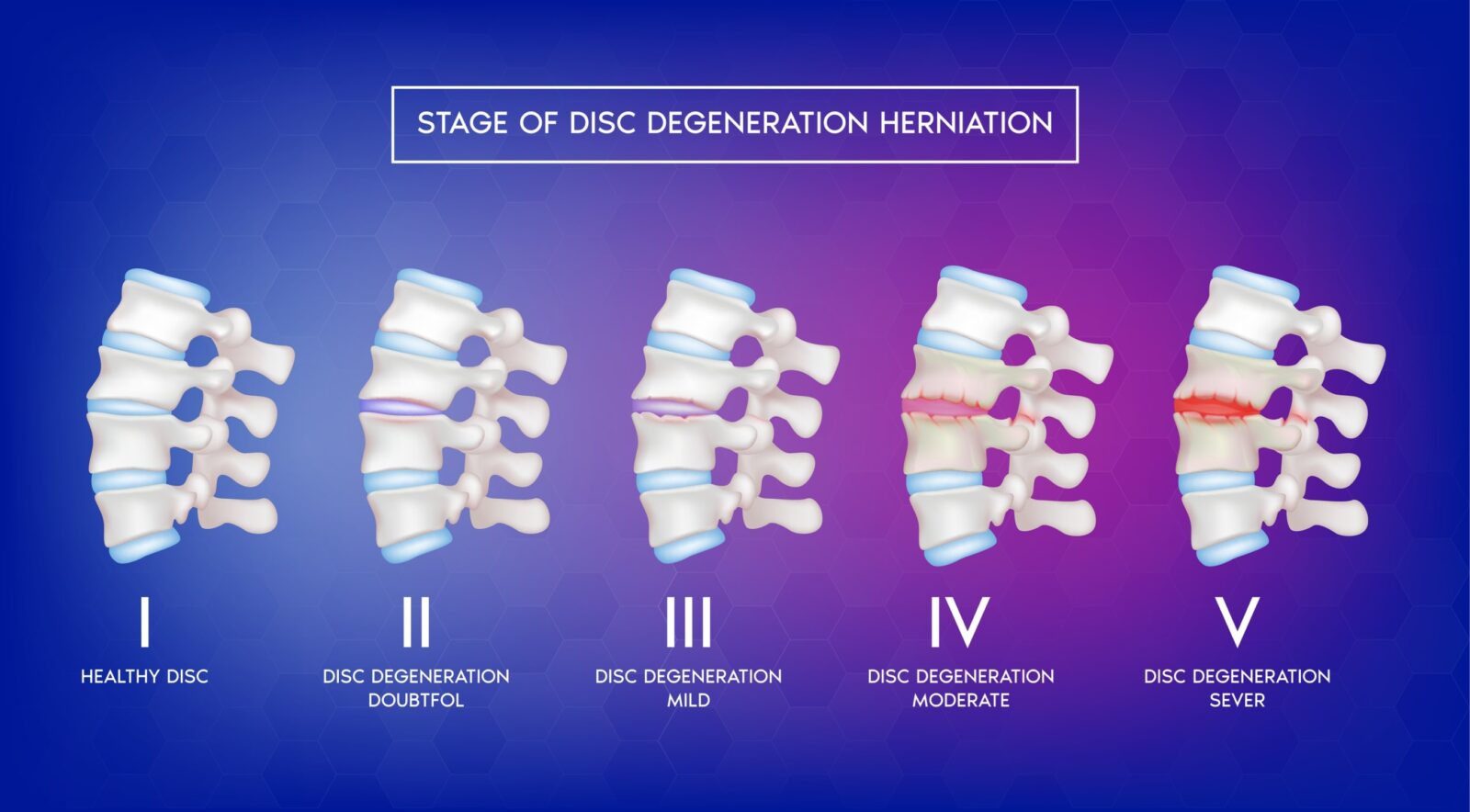Have you ever suffered from back pain and been unable to accurately diagnose the source of your discomfort? Many people struggle with this issue and are unable to find relief. If this sounds familiar, then what you may be suffering from could be a condition known as disc desiccation. Disc desiccation is an age-related degenerative condition that can cause chronic back pain, as well as some other health issues. In this blog post, we’ll delve into the symptoms of disc desiccation, how it’s diagnosed, treatment options available for those affected by it, and much more! So if you’re looking for answers regarding your back pain woes or know somebody who is – keep reading to learn more about disc desiccation!
Spinal Disc Anatomy

In order to understand disc desiccation, we must first take a closer look at spinal anatomy. The spine is composed of 33 stacked vertebrae. In between each vertebrae is a spinal disc. These discs are round and made up of a jelly-like material. They act as cushions between the vertebrae, as well as shock absorbers. These discs are composed of three main parts:
- Nucleus pulposus: a jelly-like filled center composed primarily of water. The nucleus pulposus allows for flexibility in the disc.
- Annulus fibrosus: the outer ring of the disc that provides structure and contains the liquid. The annulus fibrosus is composed of cartilage.
- Endplates: attaches the disc to the vertebrae above and below it. Endplates are composed of bone and cartilage.
When any of these parts becomes damaged, it can lead to disc desiccation.
Disc desiccation is a condition that affects the spine, causing discs between the vertebrae to dehydrate, or dry out. As a result, the discs become brittle, lose their flexibility, and become more susceptible to damage. Disc desiccation is often a natural part of the aging process, but it can also result from poor posture, trauma or injury, and other contributing factors.
Symptoms of Disc Desiccation
Disc desiccation, or deterioration of the spinal discs, is a serious but common condition amongst adults. Recognizing the symptoms early on is key to maintaining a healthy spine. With disc desiccation, you may notice the following symptoms:
- stiffness and increased pain when bending or twisting the spine
- sharp stabbing pains
- numbness or weakness in the legs and feet
- inability to stand straight for long periods of time
- tingling sensations around the neck area
- headaches
- tinnitus
- dizziness/vertigo
- loss of equilibrium
- bowel and bladder issues
It is important to note that your symptoms can vary depending on the area of the spine that is affected. In some cases, there may also be no symptoms present. If these signs are present, it’s important to seek medical help from a physician; pinpointing the cause and administering treatment can put you back on track with an improved quality of life.
Causes of Disc Desiccation
Disc desiccation is a term for degenerative changes that occur in the discs in between vertebrae, which are found in the spinal column. These changes, commonly known as dry disc syndrome, can be caused by natural processes that occur with age. As people get older, the discs in their spine become less flexible and unable to retain water as well as they once did; this results in disc desiccation. Long-term poor posture or activities that involve placing excessive strain on the spine – such as sports or lifting heavy weights – can also contribute to this condition by causing damage or wear to the discs. Furthermore, traumatic injury to the spine has been linked to increased risk of disc desiccation due to inflammation and weakening of the intervertebral discs.
There are also several spinal conditions that can cause disc desiccation. These include:
- Degenerative Disc Disease: This is a common condition where the intervertebral discs gradually break down over time due to natural wear and tear. As a result, they lose their water content and become less flexible, leading to disc desiccation.
- Spinal Osteoarthritis: This is a type of arthritis that affects the joints in the spine. Over time, it can cause damage to the intervertebral discs, leading to disc desiccation.
- Herniated Disc: This occurs when the soft, jelly-like center of the intervertebral disc pushes through the outer layer and puts pressure on nearby nerves. This can cause pain, numbness, and tingling, and may also contribute to disc desiccation.
- Scoliosis: This is a condition characterized by a sideways curvature of the spine. Over time, uneven stress on the vertebral discs can lead to disc desiccation.
- Spinal Stenosis: This is a condition where the spinal canal narrows, putting pressure on the spinal cord and nerves. It can be caused by a variety of factors, including disc degeneration and herniation, and can contribute to disc desiccation.
- Spondylolisthesis: This occurs when one vertebra slips out of place and onto the vertebra below it. This can put pressure on the intervertebral discs, causing them to lose water content and leading to disc desiccation.
Diagnosing & Treating Disc Desiccation
Diagnosing and treating disc desiccation can be complex, but with a thorough examination and evaluation, doctors can accurately diagnose the condition and create effective treatment plans. In order to properly assess disc desiccation, a physician will take into account a range of details, such as medical history, physical examination, imaging studies, and laboratory tests. Oftentimes, a computed tomography (CT) scan and/or magnetic resonance imaging (MRI) is required to determine the degree of degeneration and accompanying desiccation.
The stages of disc degeneration are commonly classified using the Pfirrmann grading system, which is based on the appearance of the intervertebral disc on an MRI scan. This system grades the disc from 1 to 5, with higher grades indicating greater levels of disc degeneration and desiccation. The stages are as follows:
- Grade I: The disc appears homogeneous with a bright white signal on MRI. This indicates a healthy disc with good water content and elasticity.
- Grade II: The disc still appears homogeneous, but the signal intensity is slightly decreased. This indicates that the disc has started to lose some water content and is less elastic.
- Grade III: The disc shows signs of damage, with small tears or fissures appearing in the outer layers. The disc also appears less homogeneous and may have a darker color on MRI. This indicates further loss of water content and elasticity.
- Grade IV: The disc is significantly damaged, with more extensive tears and fissures in the outer layers. The disc appears less homogeneous and may have a grayish color on MRI. This indicates significant loss of water content and elasticity.
- Grade V: The disc is severely damaged, with extensive tears and fissures in the outer layers. The disc appears black on MRI, indicating complete loss of water content and elasticity. This is the most advanced stage of disc degeneration and indicates the highest level of disc desiccation.
It’s important to note that not all disc desiccation will progress through all of these stages, and the severity of symptoms may not always correlate with the degree of disc degeneration. However, understanding the stages of disc degeneration can help doctors diagnose and manage disc desiccation and other spinal conditions.

The treatment options for disc desiccation will depend on the severity of the condition and the symptoms that a person is experiencing. Pain relief is typically the main objective when treating this condition, which may involve one or more of the following:
- Medications: Over-the-counter pain relievers, such as acetaminophen or nonsteroidal anti-inflammatory drugs (NSAIDs), can help to relieve pain and inflammation associated with disc desiccation. If these medications are not effective, a doctor may prescribe stronger pain medications or muscle relaxants.
- Physical therapy: Physical therapy can help to relieve pain and improve mobility in the spine. A physical therapist can design an exercise program that is tailored to a person’s specific needs, and may also use techniques such as massage or heat therapy to help relieve pain.
- Injections: In some cases, a doctor may recommend injections of corticosteroids or anesthetics into the affected area of the spine to help relieve pain and inflammation.
- Surgery: Surgery is usually only considered as a last resort if other treatments are not effective. Surgery for disc desiccation may involve removing the damaged disc and fusing the adjacent vertebrae together to provide stability and prevent further damage.
- Lifestyle modifications: Making certain lifestyle changes, such as maintaining a healthy weight, avoiding heavy lifting or repetitive motions that can strain the spine, and practicing good posture, can help to prevent further damage to the spine and improve overall spinal health.
It’s important to note that the treatment options for disc desiccation may not cure the condition, but can help to manage symptoms and improve quality of life. A doctor can help to determine the most appropriate treatment plan for an individual’s specific needs.
Preventing Disc Desiccation
Disc desiccation, the drying up of a spinal disc, is a common and very serious health problem caused by age, illness, or injury. In severe cases it can cause long-term pain and discomfort and interfere with mobility. Thankfully there are steps that you can take to reduce your risks for disc desiccation. Exercise, particularly core-strengthening exercises such as yoga, can help build muscle strength that supports and reinforces spine health. Maintaining appropriate body weight will also reduce pressure on the discs; if you are overweight it may be necessary to lose some pounds in order to improve disc health. Additionally, ergonomic practices in the workplace or at home go a long way towards keeping the spine healthy. Finally, regular stretching has been proven to reduce body aches and pains over time by reducing tension on discs and other structures in the spine. Taking these preventative measures will help ensure healthier spines, fewer aches and pains due to disc desiccation and an improved quality of life overall.
In Conclusion
To sum up, disc desiccation is a condition in which the spinal discs become dehydrated and weakened. It is caused by a number of factors such as aging, trauma or injury. It can lead to pain and other uncomfortable symptoms such as numbness or tingling. The key to managing it is early diagnosis and treatment, typically involving physical therapy or medications. Additionally, it’s important to exercise regularly and use precautions when engaging in physical activity – stretching and low impact aerobic activities are often beneficial for spine health. With preventative lifestyle changes, many patients can avoid this condition altogether. If any of these symptoms arise, it’s best to seek out medical advice from a spine specialist immediately. Scheduling a consultation with one of our spinal specialists today is an essential step towards maintaining your spine’s wellbeing – the time to act is now!











 in CA by O360®
in CA by O360®